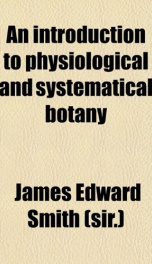an introduction to physiological and systematical botany

Purchase of this book includes free trial access to www.million-books.com where you can read more than a million books for free. This is an OCR edition with typos. Excerpt from book: CHAPTER II. PEFINITION OF NATURAL HISTORY, AKD PARTICULARLY BOTANY.OF THE GENERAL TEXTURE OF PLANTS, Natural History properly signifies that study by which we learn to distinguish from one another the natural bodies, whether Animal, Vegetable or Mineral, around us; to discover as much as possible their nature and properties, and especially their natural dependence on each other in the general scale of beings. In a more extensive sense it may be said to teach their secondary properties, or the various uses to which they have been, or may be, converted, in the service of mankmd or of other animals ; inasmuch as an acquamtance with their natural qualities is our only sure guide to a knowledge of their artificial ues. But as this definition would inelude many arts and sciences, each of them Sufficient to occupy any common mind, as Agriculture, Dietetics, Medicine, and many others, it is sufficient for a philosophical naturalist to be acquainted with the general principles upon which such arts and sciences are founded. That part of Natural History which concerns plants is called Botany, from Botkv.j, the Greek word.for a herb or grass. It may be divided into three branches ; 1st, The physiology of plants, or a knowledge of the structure and functions of their different parts; 2 dly, The systematical arrangement and denomination of their several kinds : and 3dly, Their Economical or medical properties-. All these objects should be kept in view by an intelligent botanist. The two first are of essential service to each other, and the last is only to be pursued, with any certainty, by such as are versed in the other two. The present publication is intended to explain the fundamental principles of them all, with as much practical illustration as may be necessary for those who wish...
Info about the book
Author:
Series:
Unknown
ISBN:
1177732289
Rating:
3.5/5 (5)Your rating:
0/5
Languge:
English
Users who have this book
Users who want this book
What readers are saying
What do you think? Write your own comment on this book!
write a commentif you like an introduction to physiological and systematical botany try:
Do you want to read a book that interests you? It’s EASY!
Create an account and send a request for reading to other users on the Webpage of the book!


